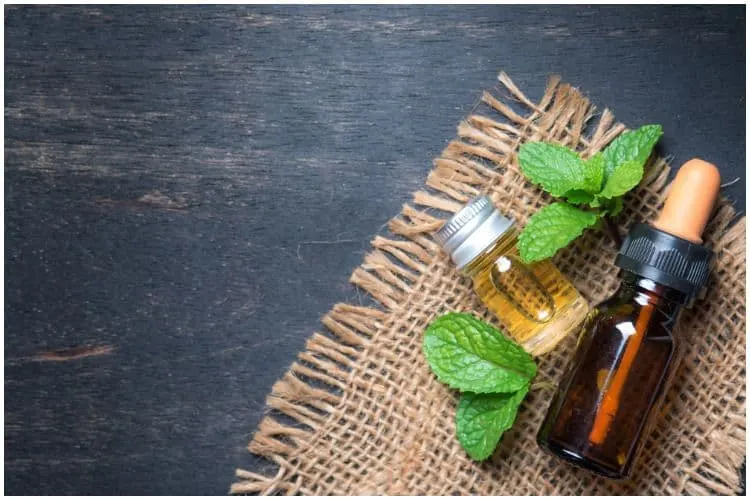What are the best essential oils for post nasal drip and cough?
Introduction
Postnasal drip is extra mucus that is felt in the back of the throat and nose and is caused by the glands in these areas.
Symptoms
Common symptoms may include:
- bad breath;
- feeling that you require to constantly clear your throat;
- scratchy throat;
- nausea from excess mucus moving into the stomach;
- a cough that is worse at night.
Causes
Common causes may include:
- weather changes;
- allergies to pollen, dust, mold, or dander;
- acid reflux (gastrointestinal reflux disease);
- infections such as influenza, the common cold (from RSV, CMV, adenovirus, and other viruses), and sinusitis;
- anatomical abnormalities, like – enlarged turbinates or a deviated septum;
- overuse of pseudoephedrine nasal sprays;
- swallowing disorders;
- foreign objects stuck in the nose;
- strep throat;
- certain medications, including antihypertensives and contraceptives;
- low humidity;
- not drinking enough water;
- eating too many dairy products (like cheese, ice cream, milk, or yogurt);
- eating spicy foods;
- dehydration;
- pregnancy and other conditions which cause an imbalance in hormone levels.
Treatment
If your symptoms don’t go away, you may require to see a healthcare provider.
He may recommend you to use some medicines, such as:
- nasal decongestant, like – oxymetazoline that constricts blood vessels in the nasal passages;
- guaifenesin, a medication that can thin the mucus;
- oral decongestant, like – phenylephrine or pseudoephedrine;
- an antihistamine, like – desloratadine, levocetirizine, cetirizine, fexofenadine, loratadine, chlorpheniramine, or diphenhydramine.
However, there are many home remedies to try, and these include:
- sleeping on propped up pillows, to keep mucous from collecting at the back of the throat;
- keeping yourself well-hydrated;
- a humidifier or steam inhalation.
List Of 11 Essential Oils For Post Nasal Drip And Cough:
Important note – to reap the complete benefits of the following essential oils to ease your postnasal drip and cough, it is recommended to:
- dilute them into a carrier oil and rub this mixture onto your chest (but, don’t let the undiluted oil touch your skin);
- place a few drops on a cotton round and inhale from there;
- inhale these essential oils by using a diffuser.
1) Peppermint
Peppermint essential oil has been used for millennia for medicinal purposes in Europe since it is extremely beneficial and versatile.
Constituents of peppermint essential oil include:
- carvone;
- menthol;
- pulegone;
- menthone;
- b-caryophyllene;
- pulegone;
- β-myrcene;
- rosmarinic acid;
- limonene;
- isomenthone;
- limone.
This essential oil provides effective relief from a variety of respiratory problems, such as – sinusitis, asthma, nasal congestion, the common cold, postnasal drip, bronchitis, and cough.
Therefore, if you are suffering from any type of respiratory problem, adding several drops of peppermint essential oil to an essential oil diffuser can help clear your nasal passages so your symptoms can improve.
2) Lavender
It is extracted from Lavandula angustifolia of the Lamiaceae (Labiatae) family.
Its main active compounds include:
- lavandulyl acetate;
- β-caryophyllene;
- geraniol;
- linalyl acetate;
- linalool (30.6 %).
Lavender essential oil is widely used for various respiratory problems, including flu, cough, cold, throat infection, sinus congestion, bronchitis, postnasal drip, asthma, laryngitis, whooping cough, and tonsillitis.
Note – its potent antimicrobial ability is enhanced when it is mixed with other essential oils, such as – cinnamon, clove, and tea tree oil, according to a study that was issued in the Evidence-Based Complementary and Alternative Medicine.
3) Lime
Lime essential oil is produced from Citrus aurantifolia of the Rutaceae plant family.
The health benefits of this oil can be attributed to its properties as a:
- tonic;
- antiseptic;
- restorative;
- hemostatic;
- antiviral;
- febrifuge;
- disinfectant;
- bactericidal;
- aperitif;
- astringent.
For coughs, sinusitis, colds, chest congestion, post nasal drip, and a sore throat, add several drops of this essential oil to a bowl of steaming water and inhale it.
In addition, you can blend a few drops with a carrier oil, then rub it on your chest and neck.
4) Lemon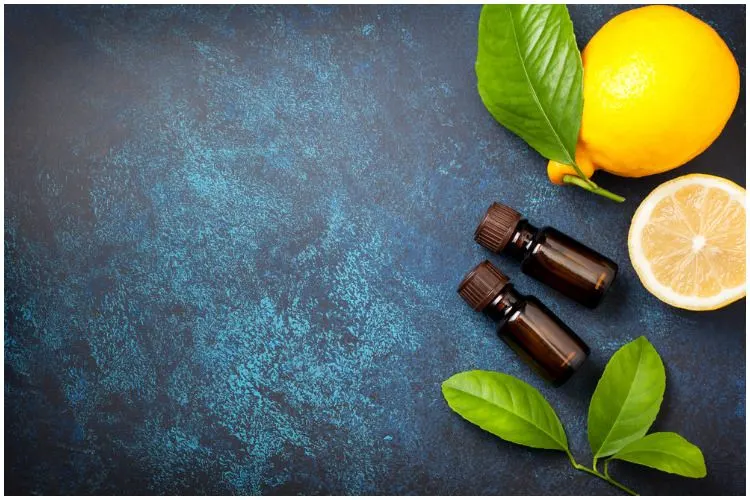
Lemon (botanical name – Citrus limon) is a flowering plant that belongs to the Rutaceae family.
It has potent antifungal and antibacterial properties, that work as a natural remedy for many oral conditions, including bad breath, sinusitis, post nasal drip, or oral thrush.
Moreover, lemon essential oil is calming in nature and may help in eliminating exhaustion, dizziness, mental fatigue, nervousness, anxiety, and nervous tension.
5) Eucalyptus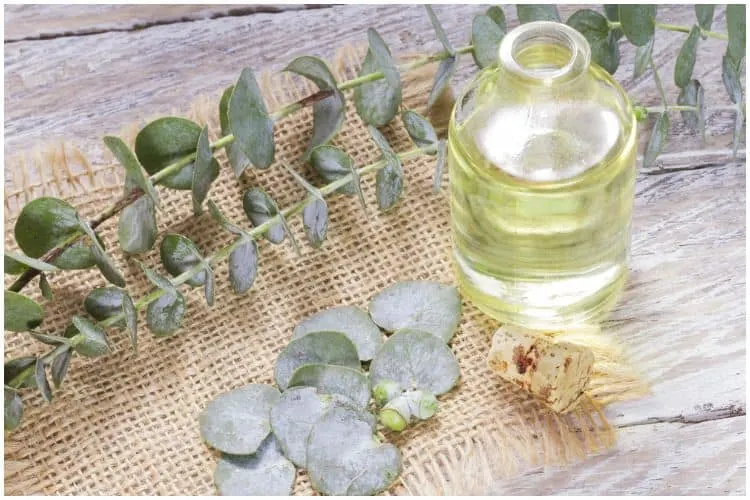
It is steam distilled from the leaves of the eucalyptus tree.
The major constituents of eucalyptus essential oil are:
- α-pinene (1.27 to 26.35 percent);
- 1,8-cineol (49.07 to 83.59 percent).
According to recent research, this oil is effective in curing headaches, sinus infections, and allergies.
Also, it is an expectorant.
Other scientifically-proven benefits of eucalyptus oil include:
- repels and kills arachnids and insects;
- reduces inflammation in the body;
- kills pathogenic bacteria and fungi;
- neutralizes free radicals.
6) Geranium
The essential oil of geranium is produced through steam distillation of leaves and stems of the geranium plant (botanical name – Pelargonium odorantissimum).
It reduces feelings of anxiety, sadness, stress, tension, and fatigue.
In addition, this essential oil improves cognitive function, clears the symptoms of nasal congestion, boosts concentration, and balances the hormones.
The geranium essential oil may also be used for skin issues, such as dermatitis (a medical term that describes an inflammation of the skin) and eczema.
7) Marjoram
Marjoram essential oil (scientifical name – Origanum majorana) is obtained from a plant cousin of oregano.
The health benefits of this essential oil can be attributed to its potent properties as an antispasmodic, aphrodisiac, analgesic, antiviral, antiseptic, and bactericidal.
It is capable of treating several respiratory tract conditions, as per a 2009 study which was issued in the American Journal of Chinese Medicine.
Note – if pregnant or under a doctor’s care, consult your physician prior to use.
8) Frankincense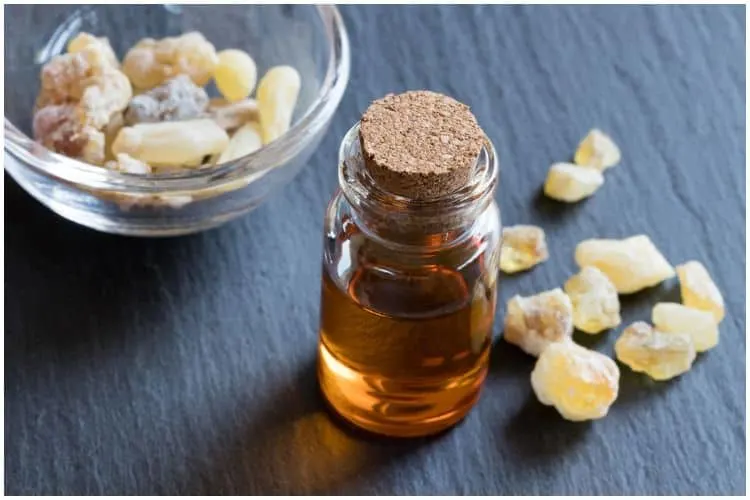
Frankincense essential oil is one of the most popular natural remedies on the market today and is known as the “King of Oils.”
The healing benefits of this essential oil are due to its strong anti-inflammatory properties as well as its content of boswellic acid, which has the capacity to modify the immune system.
9) Rosemary
Rosemary (scientifical name – Rosmarinus officinalis) is a small evergreen plant that is part of the mint family, which also includes the herbs basil, myrtle, lavender, and sage.
The primary chemical components of rosemary essential oil include:
- limonene;
- 1,8-cineole;
- camphene;
- bornyl acetate;
- camphor;
- b-pinene;
- borneol;
- a-pinene.
Regularly using rosemary essential oil helps to stimulate the immune system and clears up the sinuses, nose, and throat.
10) Cedarwood
It is manufactured from the wood of the cedar tree through a process known as steam distillation.
Its benefits include:
- acts as a natural astringent;
- fights microbes;
- helps reduce infection;
- reduces inflammation;
- helps treat symptoms of the respiratory disease;
- helps manage seborrheic dermatitis;
- removes toxins from the body;
- helps reduce the frequency of spasms.
11) Tea Tree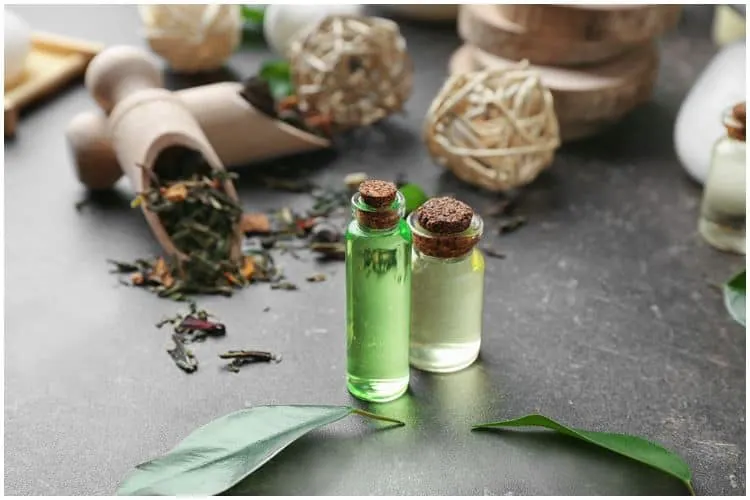
Tea tree essential oil is extracted through steam distillation of leaves and twigs of tea tree (scientifical name – Melaleuca alternifolia).
It may provide support to the human body in the following ways:
- clearing denture stomatitis, gingivitis, and other forms of oral infection;
- fighting pathogenic bacteria, including methicillin-resistant Staphylococcus aureus;
- preventing head lice;
- eliminating dandruff;
- fighting acne vulgaris, a condition that involves the inflammation or blockage of the pilosebaceous units;
- treating fungal and yeast infections, such as – tinea unguium (fungal infection of the nails), tinea pedis (ringworm), and candidiasis (candida);
- targeting viruses, such as – cold sores and fever blisters.
Image source – Shutterstock
ALSO READ: Hydrogen Peroxide vs Rubbing Alcohol For Cuts & Wounds – Differences
References https://www.sciencedirect.com/science/article/pii/S095461110900153X https://www.ncbi.nlm.nih.gov/pmc/articles/PMC3332192/ https://www.sciencedirect.com/topics/medicine-and-dentistry/post-nasal-drip https://www.ncbi.nlm.nih.gov/pubmed/19481918

